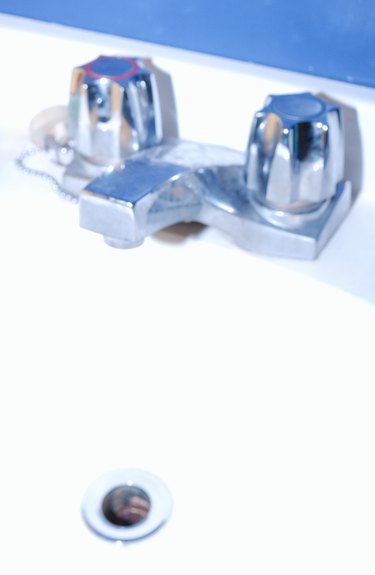
A rancid odor coming from your sink drain may just be coming from debris in the P-trap, but if it smells like a sewer, it probably means venting problems in your drain system. When the vents are blocked, flushing a toilet can create sufficient vacuum to suck water out of the trap and allow sewer gases into your home. The smell may abate when you use the sink and replenish the water in the trap, but it will return whenever someone uses the bathroom, unless you unblock the vents. That isn't as hard to do as it sounds.
Step 1
Inspect the P-trap underneath the sink for leaks. If the trap is leaking, the water level inside it may be to low to seal out sewer gases. If the trap is leaking from one of the connection nuts, tighten the nut with adjustable pliers. If there is a hole or crack in the plastic, replace the trap.
Video of the Day
Step 2
Diagnose a venting problem by running water in the sink. Flush the closest toilet and listen for gurgling sounds coming from the sink. The sounds mean that the flow of water from the toilet is sucking air through the drain.
Step 3
Disconnect the trap and inspect the water level inside it. If there isn't enough water to fill the inverted "P" and seal out sewer gases, you'll need to unblock the vents connected to the toilet and the sink.
Step 4
Climb on the roof and inspect the vent openings, which are usually just above the main bathroom. Clear away any debris blocking the openings. Reach inside to pull away any that has collected just past the opening.
Step 5
Loosen blockages deeper inside the vents with a garden hose. Screw a nozzle on the hose and adjust it to its most forceful setting. Turn on the water all the way and spray water into the vent openings. If the stream doesn't clear the blockages, water will back out of the vent openings.
Step 6
Insert the head of a 20-foot sewer auger into the vent openings to clear obstructions that are too stubborn to remove with water. Push the auger in as far as it will go, and when you encounter resistance, crank the handle. The auger head will eat its way through the obstruction.
Step 7
Work the auger until water starts flowing down the pipe. You may have to clear more than one obstruction before this happens. Pull the auger out and double-check the vent by spraying a continuous stream of water into it for one or two minutes. If it doesn't back up from the opening, the vent is clear.
Video of the Day